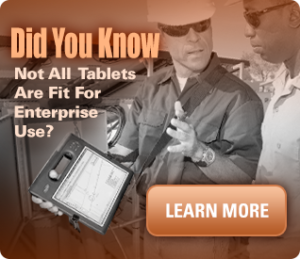Recent advances in technology have allowed businesses to instantaneously receive, interpret, and distribute information. The desire to be more productive and competitive has resulted in the widespread use of mobile devices, specifically tablets, in the workplace.
As with any other form of technology, there are a wide variety of tablets to choose from. Businesses looking to incorporate enterprise mobility into their enterprise mobility strategy need to carefully consider their mobility needs before choosing a tablet.
A company should start by determining whether to go with a consumer or rugged tablet. Although they largely function in the same way, both types have their advantages.
Here are a few things to consider when shopping for tablets:
Price
There is a noticeable difference between consumer and rugged tablets in terms of price. Consumer tablets tend to be inexpensive; depending on the brand, they can range from $200 to $600 or more. A good rugged tablet will usually cost upwards of $1500.
Rugged tablets cost more for a reason: they are specifically designed to withstand wear and tear, even in extreme conditions. This isn’t to say consumer tablets are poorly made; they just aren’t built for high-risk environments.
While consumer tablets may seem cost-effective at first glance, it’s important to evaluate the total cost of ownership (TCO)—the overall expense of a device throughout its lifecycle. Although the initial purchase price of consumer tablets is lower, they often require more frequent repairs compared to rugged tablets. These repairs add unexpected costs that aren’t reflected in the upfront price. In addition, device downtime can slow business operations, reduce productivity, and negatively impact output. To maximize efficiency and control long-term costs, businesses should not only consider rugged devices but also implement mobile device management solutions that streamline maintenance, minimize downtime, and keep devices secure and fully operational.
Durability
Rugged tablets, as the name implies, are extremely tough and durable products. Even though they are much more expensive than consumer tablets, they are built for tough environments. Therefore, they require less maintenance during their lifespan.
Consumer devices have a lower cost up-front, but when you consider the amount of money you’ll spend on repairs, they end up costing more over time. Tablet cases are available to increase durability — but even though they can offer some protection, no case, no matter how durable, will turn a consumer tablet into a rugged tablet.
Here are a few things you can get from a rugged tablet that a consumer tablet simply can’t offer:
- Drop/shock protection: Rugged tablets are built to withstand the impact of a jarring fall. Because of their industrial purpose, warehouses aren’t ideal places for most types of technology. However, a fall to concrete won’t hurt a rugged tablet. Consumer tablets, with the help of a case, might appear to withstand a fall, but the shock of just one fall could ruin the tablet internally.
- Water/dust-proof: This is an important one. Even in office settings, spills frequently happen around electronics. A tablet that can resist bad weather or a dirty/dusty workplace is invaluable in industrial environments like warehouses and distribution centers.
- Operate in extreme temperatures: Unlike temperatures in office environments, temperatures in warehouses fluctuate more and are harder to control. Tablets that shut down due to extreme heat or cold result in downtime, lower output, and ultimately, lost revenue.
- Longevity: In addition to failing less often than consumer tablets, rugged tablets also have longer life spans. This means that they won’t need to be replaced as often, reducing their TCO.
Design is a much more subjective category than price and durability, but it is just as important. Usability is essential, and should be one of the most important considerations.
Businesses should choose a tablet with software that allows workers to do their job quickly and easily. For example, organizations that rely on RFID technology for tracking assets or inventory may benefit from tablets that integrate this feature seamlessly into daily workflows.
Companies that require workers to wear gloves should choose a tablet with resistive touchscreen panels (a type of screen that works even when gloves are being worn).
Similarly, businesses that frequently deal with signatures might want a digitizer touchscreen, which uses a special pen that allows for easy writing.
These are just a few examples of the importance of usability in choosing a rugged tab
The average warehouse is going to require a more durable tablet, but every business has different needs. Tablets are designed for many types of uses, and that is why one kind of tablet will never be inherently better than another. Cost, durability, and design are just a few factors to consider when shopping for tablets. A business that understands what it needs in a tablet can save a lot of money and increase productivity.



